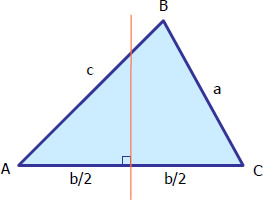Definition of a Triangle
Triangle is a polygon with three sides and three vertices. It can also be defined as closed figure bounded by three straight lines called sides. If three sides of a triangle are equal, it is an equilateral triangle. An equilateral triangle is also equiangular. It two sides are equal, it is an isosceles triangle. While, scalene triangle is a triangle with no two sides are equal.
In Euclidean geometry any three points, when non-collinear, determine a unique triangle and a unique plane (i.e. a two-dimensional Euclidean space). Egyptian triangle is a right triangle with sides equivalent to 3, 4 and 5 units.
Measures of Angles
A degree (°) is defined as the measure of the central angle subtended by an arc of a circle equal to 1/360 of circumference of the circle. A minute (') is equal to 1/60 of a degree. A second ('') is equal to 1/60 of a minute.
A radian (rad) is defined as the measure of the central angle subtended by an arc of a circle equal to the radius of the circle.
The circumference of a circle is defined as the length of the total arc of the circle, is numerically equal to 2π times the radius and subtends an angle of 360°

TIPS:
1. Complementary angles are two angles whose sum is 90° or right angle.
2. Supplementary angles are two angles whose sum is 180° or straight angle.
3. Explementary angles are two angles whose sum is 360° or perigon.
In general, there are only two kinds of triangle:
1. Right triangle - a triangle with one interior angle is exactly 90°.
2. Oblique triangle - a triangle without a right angle.
Oblique triangle may either be:
1. Acute triangle - a triangle with all of interior angles are less than 90°.
2. Oblique triangle - a triangle with one of the interior angles is greater than 90°.

The follwing give the basic formulas using different kinds of triangles:
RIGHT TRIANGLES

ISOSCELES RIGHT TRIANGLES

30° - 60° TRIANGLES

EQUILATERAL TRIANGLE

OBLIQUE TRIANGLE (given three sides)

Other Formulas of a Triangle:
- Given two sides and included angle
- Given three angles and one side
- Triangle with inscribed circle
- Triangle inscribed in a circle
- Triangle with escribed circle


Symbols and Notations
a, b, c = lengths of sides of a triangle
A = area of a figure or polygon
V = volume of a solid
C = circumference of a circle
P = perimeter
hc = altitude to side c
d = diagonal of a polygon or diameter of a circle
r = radius of a circle, or a radius of an inscribed circle in a polygon (apothem)
R = radius of circumscribed circle
s = side of a polygon, or one-half of the perimeter of a triangle, or length of a circular arc.
TRIVIA:
The symbols + and - for plus and minus, respectively was introduced by German mathematician and astronomer, Johannes Regiomontanus in 1456.





















































